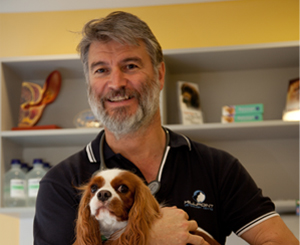Blog
Surgical treatment of cruciate ligament rupture in dogs
February 17th, 2012
Injury to the anterior cruciate ligament of the stifle joint (equivalent to our knee) is one of the most common causes of hindlimb lameness in dogs.
As such, I felt it might be useful to attempt a limited overview of the options available to clients for treatment of this injury in their pets. This post has been two years in the writing because a challenging case in 2010 made me re-examine my surgical technique and the advice I offer to clients.
The anterior cruciate ligament (ACL) is the thickest strongest ligament in the dog’s stifle/ knee and is vital for the stability of that joint
In choosing a surgical technique the weight and age of the patient are critical, as is the level of activity expected by the owner after surgery. Be aware too that there is a spectrum of cruciate disease from the classic non weight bearing lameness at exercise that follows acute total rupture of the ACL down to the gradual and perhaps only partial rupture of the ligament.
For the last two years my technique of choice for dogs 17kg and under has been to use an tie external to the joint anchored under the lateral fabella (a small bone behind the knee joint). The material I use is called LigaFibre, I source it from a surgical specialist in Queensland and in dogs of this size repair is very successful.
I have trialled Ligafibre for larger dogs but the results leave something to be desired. Currently I have reverted to an old but effective technique where a graft of connective tissue is harvested from the surface of the thigh muscles and passed through the joint which has been opened surgically.
Regardless of size, I consider it mandatory for any patient having cruciate surgery at Millpoint to see Dr Liz Frank for post operative therapy aimed at relieving muscle pain and improving muscle strength. This accelerates the recovery from surgery.
Sometimes a dog will present with a thickened stifle indicating chronic cruciate injury or disease. If the joint is no longer unstable I do not take that patient to surgery but concentrate on managing the inevitable osteoarthritis with medication.
Cost of the surgery I’ve outlined above is $1000, and Dr Frank’s fees will add just over $200 to that.
I do not purport to be a specialist surgeon, and the methods I’ve described are drawn from my own experience and limited by my surgical equipment and skill.
Other, more modern techniques such as Tibial Plateau Levelling Osteotomy (TPLO),Tibial Wedge Osteotomy(TWO), and Tibial Tuberosity Advancement (TTA) involve cutting the tibia (the shin bone) to alter the geometry of the joint and so restore stability. They are available in Perth from several excellent specialist orthopaedic surgeons.
Do they give a better result? No question. Do they cost more? Yes,several times more. My estimate, and I’m happy to be corrected ,would be $3000-5000.
And so the onus falls on you,the owner, to weigh up the options. For a small or medium size dog which by age or inclination has a less active lifestyle, a Ligafibre fabellar tie should do just fine. For a larger breed dog with no pretensions to athleticism, we should be able to give you an acceptable result after surgery at Millpoint. But if you have a canine agility champion,a very bouncy young large or giant breed,or if you as an owner are unwilling to accept any reduction at all in your dog’s athletic ability; you should consider referral to a specialist surgeon.
Posted in News
